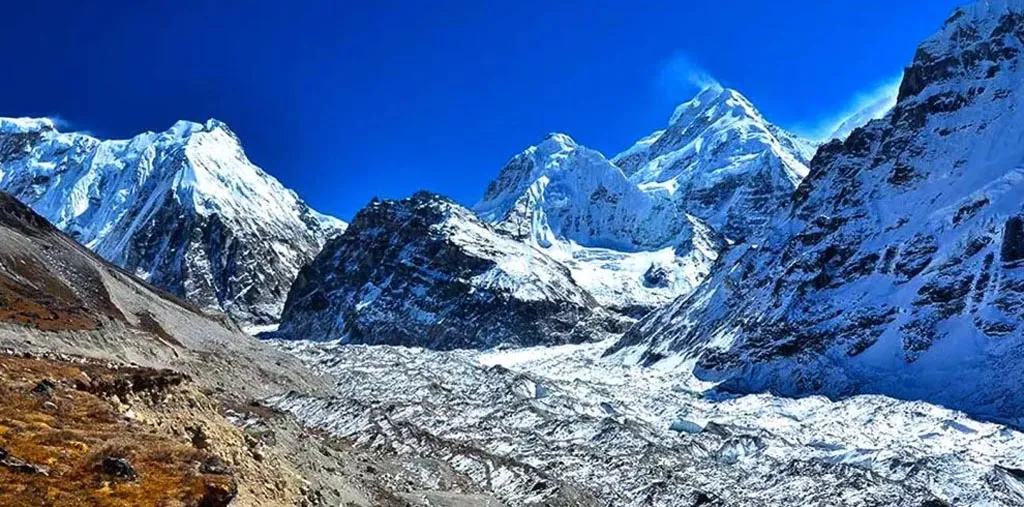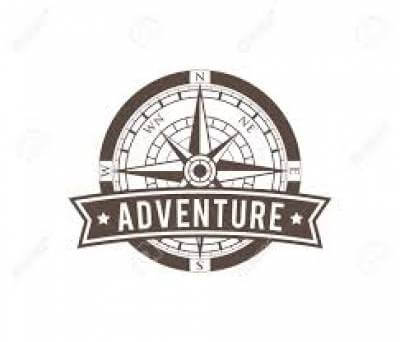Kanchenjunga Base Camp Trek
This famous Kanchenjunga Base Camp trek takes you to both the north and south base camps of Mt. Kanchenjunga (8586m) the third world’s third-highest mountain. This 20 day Kanchenjunga Circuit Trek is famous for its glorious snow-clad peaks, high altitude alpine crossings, lush green valleys, and raging glacial rivers - all in one complete package!
Mt. Kanchenjunga is situated on the border with Sikkim in India and Tibet. The north and south case camp of Kanchenjunga are isolated, unspoiled, and will leave you awestruck. This is a trek to divine heights and the memories will last you a lifetime.
There are some physical challenges along the trail, such as the high altitude Lapsang La Pass (5108m) and Sinon/Mirgin La Pass (4650m) and Kanchenjunga Base Camp at 5140m. You will have time before reaching these heights to acclimatize at lower levels.
Mount Kanchenjunga, meaning "Five treasures of the snow" is within the protected Kanchenjunga conservation area, established in 1997 and covers over 2035 sq km.
The World Wildlife Fund (WWF) has classified the Kanchenjunga Conservation Area Project (KCAP) as a Global Eco Region. There are a number of fascinating species in this region, such as red panda, wild bear, musk deer, blue sheep, rhesus macaw, and the elusive snow leopard. The birdlife along the trek is abundant and brings the forests alive with song. There are over 1200 types of flowering plants, 69 kinds of orchids and 30 rhododendron species that brighten the trail – most especially during spring.
As well as Kanchenjunga there are four other peaks exceeding 8,000m, one is Kanchenjunga West, also known as Yalung Kang (8,586m). There are more than 17 peaks with an altitude of more than 7000m, including Kambachen (7,903m), Janu (7,710m), Jongsong (7,483m), Kabru (7,353m), Tent Peak (7,365m) and the Twins (7,350m). Besides these massive peaks there are a number of peaks over 6,000m. Surrounded by this astounding cluster of peaks are five major glaciers: Zumu, Talung, and Rathong that run into Sikkim and in the west the Kanchenjunga and Yulang Glaciers that flow into the extraordinary swift Tamor River in Nepal.
The trek along the Kanchenjunga Circuit is rough and at times physically demanding and hard going, but this is what makes this trek different from the rest.
ITINERARY
Day 1 : Arrival in Kathmandu and transfer to hotel (1,400m).
On your arrival at Kathmandu Tribhuvan International Airport, you will be met by Sherpa Expedition and trekking staff and transferred to your respective hotels followed by a briefing regarding Kanchenjunga Base Camp Trek.
Day 2 : Explore Kathmandu and prepare for trek
Today, we will spend the day sightseeing in Kathmandu Valley with our guide. We will visit Pashupatinath, which is regarded as the holiest Hindu temple in Nepal and where pilgrims worship Lord Shiva (situated on the banks of the holy Bagmati River), Bouddhanath, a Buddhist temple known as ‘Little Tibet’ and then on to Swayambhunath known as the Monkey Temple. From Swayambhunath we drive to Kathmandu’s famous Durbar Square, a UNESCO World Heritage-listed site and located in front of the old royal palace. Upon arriving back at your hotel you may have time to do some last-minute shopping around Thamel – the tourist hub of Kathmandu. Back at your hotel your guide will help you prepare for your trek.
Day 3 : Fly from Kathmandu to Bhadrapur (45 min) & drive to Suketar (2,420m) Duration: 8-10 hours.
Today we will pick you up from your hotel and take you to the airport for your flight to Bhadrapur and then we will drive to Suketar, a seven to eight-hour drive. We will stay overnight at Suketar.
Day 4 : Trek from Suketar to Lali Kharka (2,266m) Duration: 4-5 hours.
Today our trek begins with a relatively relaxed four to five-hour hike through lush forests and finally on to Lali Kharka Village where we stay the night.
Day 5 : Trek from Lali Kharka to Kande Bhanjyang (2,190m) Duration: 5-6 hours.
After an early breakfast we follow the trail that ascends to Simbu Village and then have a steep ascent to Kande Bhanjyang Village. Along the trail we pass through several small village and forested areas before reaching Kande Bhanjyang Village where we stay the night.
Day 6 : Trek from Kande Bhanjyang to Phumphe Danda (1,860m) Duration: 6-7 hours.
Today’s trail takes us up a steep hillside passing terraced farmlands situated high above Kabbeli Khola (river). The trail is undulating, passing through valleys and across hillsides. We will stop for lunch along the way and after lunch pass through Anpan Village before descending to c Kashawa Khola (river) which we cross and then begin climbing up through the fields until we reach Phumphe Danda Village where we stay overnight.
Day 7 : Trek from Phumphe Khola to Yamphudin (2,080m) Duration: 6-7 hours.
The trail today follows the contours of the hillside above the Kabeli Khola (river), traversing small rivers and valleys. There are several great places to stop and take a dip in the river as we follow it until reaching Yamphudin Village. We will also stop beside the river for lunch. We will stay at Yamphudin in a guest house tonight.
Day 8 : Trek from Yamphudin to Tortong (2,995m) Duration: 8-9 hours.
Our trail today leads us through cooling forests and along the way offers amazing views of the Himalayas. The trail follows the Amji Khola. Further down the trail we cross Lassiya Bhanjyang Pass before reaching Tortong where we will stay the night in a guest house.
Day 9 : Trek from Tortong to Ramche (4,610m) Duration: 6-7 hours.
We start today by following the trail next to the river, passing through lush rhododendron and conifer forests. The trail descends rather rapidly down to the valley of the Simjua Khola (river). We then climb to the base of the Yalung Glacier and through valleys until we find a good campsite for the night. The trail today takes us near-frozen alpine lakes, across crystal clear rivers and offers magnificent views of Koktang, Rathong, and Kabru peaks. Tonight we will sleep soundly due to the physical exertion at these higher
Day 10 : Explore vicinity of Ramche (4,610m) and Trek to Oktang (4,730m) Duration: 4-5 hours.
Today we have our first close up view of Mt. Kanchenjunga. Soon after beginning our trek we will have impressive views of the south face of Mt. Kanchenjunga and Jannu. After spending the morning at Ramche we head to Yalung Ri Glacier and to Oktang. From this altitude we have breath-taking views of the surrounding mountains, especially the towering east face of Jannu Peak. Tonight we stay here in a guest house.
Day 11 : Trek from Oktang to Yalung Ri Base Camp (4,840m) Duration: 4-5 hours.
Again we begin by climbing higher as we head to Yalung Base Camp. Crossing these high altitude passes requires a good energy level and fine weather. The trail is more difficult but more rewarding as the views become more spectacular, especially of the stunning Mt. Kumbakarna (Jannu), Nyukla Lachung, and other nearby Himalayan snow-clad peaks. We will stay here overnight in a guest house.
Day 12 : Trek back to Tsheram (Cheram) (3,800m) Duration: 5-6 hours.
Along the trail we continue to have awesome views of Yalung Glacier, a frozen lake, and numerous lush valleys. Tonight we stay at Tsheram in a guest house.
Day 13 : Trek from Tsheram to Selele (4110m) via Mirgin La Pass (4,645m) Duration: 7-8 hours.
The trail heads down into the valley and along the way pass the trail that leads to the physically demanding Lapsang La Pass trail to Ghunsa and the north side of Kanchenjunga. This pass is dangerous, so we will head across the southern passes crossing Mirgin La Pass. At the beginning it is a steep ascent to reach the pass. On reaching the pass we have fantastic panoramic views of Jannu, and further away in the distance Mt. Makalu, Gyakung Kang, Everest, Lhotse, and Chamalang. Today’s trek will take about six to seven hours and will leave you tired and ready for a good night’s sleep at our campsite tonight.
Day 14 : Trek from Selele to Ghunsa (3,415 m) Duration: 5- hours.
Our trek today descends through pine and rhododendron forests until we reach Ghunsa, the last village in the valley. Ghunsa is a charming Tibetan village with many wooden houses displaying fluttering prayer flags. Ghunsa has two monasteries that are worth a visit. Tonight we stay at Ghunsa in a guest house.
Day 15 : Trek from Ghunsa to Kambachen (4,145m) Duration: 5-6 hours.
The trail today ascends to the south of Ghunsa Khola (river) crossing the broad river flats until we reach the elevated pastures on the north banks of the river. Along the trail we have magical views of. Mt Jannu. Once we arrive at the small Tibetan village of Kambachen we find ourselves surrounded by mountains. Tonight we stay here in a guest house.
Day 16 : Trek from Kambachen to Lhonak (4,792m) Duration: 3-4 hours.
Our trail crosses a rocky landscape until we reach Ramtang Village (4240m) then crosses to the northwest of the Kanchenjunga Glacier before reaching Lhonak, situated on a sandy plain with magnificent mountain views surrounding us. Tonight we will find a sheltered area to set up our tents in this arid windswept region.
Day 17 : Trek from Lhonak to Pang Pema (North base Camp) (5,143m) Duration: 4-5 hours.
Kanchenjunga peak is only visible from Pang Pema, the base camp for mountaineers wanting to climb Kanchenjunga. The trail ascends across the arid plain but very quickly gets steeper as we traverse the moraine. Tonight we stay at a guest house at Pang Pema.
Day 18 : Explore around Kanchenjunga Base Camp (5,143m) and Return to Kambachen; Duration: 5-6 hours.
An early morning climb of about 200 to 300m up a ridge north of Pang Pema offers magical views of Kanchenjunga, Wedge Peak, the Twins, and Tent Peak. We will then head back to Kambachen where we will stay in a guest house for the night.
Day 19 : Trek from Kambachen to Ghunsa (3,415m) Duration: 5-6 hours.
We head back on the same trail all the way to the Tibetan village of Ghunsa where we will stay the night in a guest house.
Day 20 : Trek from Ghunsa to Amjilosa (2,498m) Duration: 6-7 hours.
After an hour’s trek we descend to Phale, home to several monasteries and juniper forests until arriving at a grassy hillside where the tiny village of Amjilosa lies. We stay here in a guest house tonight.
Day 21 : Trek from Amjilosa to Sakathum (1,650m) Duration: 5-6 hours.
The day begins with a short climb and then a steep descent for the remainder of the day. At the beginning of our trek we can see a waterfall cascading form the mountains. Out trail leads to the junction of the Tamur and Ghunsa Kholas (rivers) and finally to Sakathum where we stay in a guest house for the night.
Day 22 : Trek from Sakathum to Chirwa (1,185m) Duration: 5-6 hours.
Our trek begins with a crossing of the Simbu Khola, a river with its origins at Kanchenjunga’s south base camp. The temperature is warmer at these lower altitudes. We cross a number of small streams before reaching Chirwa, a small village set among large boulders. Tonight we stay here at a guest house.
Day 23 : Trek from Chirwa to Taplejung (1,820m) Duration: 6-7 hours.
The trail today passes through more lush forests with unique examples of various flora and fauna. Our trek today lasts for about eight to nine hours before we reach the quaint village of Taplejung where we stay in a guest house overnight. On our way, we can witness a lush forest filled with flora and fauna. About 8-9 hours of long walk we reach to a picturesque village, Taplejung, where we stay in a guest house overnight.
Day 24 : Drive from Taplejung back to Bhadrapur (2,08m) Duration: 8-10 hours.
The nine to ten hour road trip takes us through many small valleys and through villages until we reach Bhadrapur where we stay in a guest house for the night.
Day 25 : Fly back to Kathmandu & transfer to hotel Duration: 45 minutes flight.
Today we have a 45-minute scenic flight back to Kathmandu and have our final glimpses of the majestic snow-covered mountains. Sherpa Expedition and Trekking will take you back to your hotel.
Day 26 : Transfer to Tribhuvan International Airport.
Your adventure comes to an end today – but your memories will last a lifetime! Our company representative will take you to the airport approximately 3 hours before your scheduled flight. On your way home you'll have plenty of time to plan your next adventure and explore the most magnificent mountains of Nepal.
SERVICES
Costs Included in your package:
- Airport picks up and transports by private Car/Jeep.
- Three night’s standard twin sharing Hotel in Kathmandu with breakfast.
- Three meals a day (Breakfast, lunch, and dinner) during the trek.
- Transportation from Bhadrapur to Suketar and Taplejung to Bhadrapur by sharing Jeep.
- Trekking Lodge (Tea House)/ tent accommodation during the trek.
- All necessary paperwork including Kanchenjunga conservation area Entry Permit & Special permit.
- Kathmandu-Bhadrapur-Kathmandu flight with private airport transfer and domestic airport tax.
- A highly experienced, helpful, knowledgeable, friendly, English speaking well trained, Government license holder guide with all his salary, food, drinks, accommodation, transport and insurance.
- Strong, helpful Sherpa porters with proper safety equipment and walking equipment, his salary, food, accommodation, and insurance (one porter for two people).
- Comprehensive medical supplies (first aid kit will be available).
- Arrangement of emergency helicopter service (paid by your Travel Insurance Company).
- Use of sleeping bag, down jacket, duffel bag and walking poles (if you don’t have your own, to be returned after trip completed).
- Sherpa Expedition and Trekking T-shirt
- Government taxes and official expenses.
- Guided Kathmandu sightseeing tour with private car/jeep.
- Oxygen meter to check your pulse and oxygen saturation and heart rate twice daily (Very useful to check Altitude Mountain Sickness(AMS) symptoms) which will ensure your health during the trek.
- Assistant guide for groups of 8 or more people.
Costs Exclude
- Meals whilst you are in Kathmandu - lunch, and dinner.
- Nepal entry visa fee (easy to obtain the visa on arrival at Tribhuvan International Airport – Kathmandu). $30 USD for 15-day, $50 USD for 30 Days, and $125 USD for 90 Days visa.
- Personal travel and medical insurance.
- International airfare.
- Your personal expenses.
- All the alcoholic and nonalcoholic, soup, tea, coffee, hot chocolate, cocoa, mineral water, extra food, cold and hot drinks on trek ( i.e. those you choose to purchase along the way and during evenings in the tea houses)
- All desserts & sweet things like chocolate, cake, pie, pudding.
- Hot shower and battery charging at the tea houses.
- Tips for the guide, porter, and driver (tipping is expected)
- Kathmandu sightseeing monument entrance fees($30 USD per person)
- Excess baggage of more than 20 kg for Badarpur flight.
EQUIPMENTS
The following information will give you some idea about what you need to bring for the trek. It is important you do not forget the essential items, as this will determine your comfort and safety on the trek. Equally important is that you do not burden yourself with unnecessary equipment on the trek.
- Sleeping Bag (Sherpa Teams will provide but need to return after completing the trip)
- Duffel Bag (Sherpa Teams will provide but need to return after completing the trip)
- Fleece jacket or pullover
- Waterproof windbreaker or windcheater
- Thermal underclothes
- Rain poncho
- Down jacket (Sherpa Teams will provide but need to return after completing the trip)
- Fleece or wool trousers
- Sun hat or scarf
- Trekking pants (two pairs)
- Mittens or woolen gloves
- Hiking socks (several pairs)
- Moisture-wicking shirts, including t-shirts
- Trekking shoes or boots with spare laces
- Flip-flops or sandals for relaxing in the evenings
- Underwear (several pairs)
- Swimsuit or swimming costume
- Sunglasses
- Headlamp or flashlight/torch
- Sleeping bag (Sherpa Teams can provide this for you)
- Trekking poles (if desired)
- Hiking backpack with a capacity of at least 40 liters
- Small lock for your backpack
- Reusable water bottles (at least two liters)
- Water purification tablets or filtration device
- Wash towel
- Basic first aid kit
Toiletries (tissues, toilet paper, moisturizer, lip balm, sunscreen, sanitary pads, hand sanitizer, nail clippers, a small mirror, toothbrush, toothpaste, glasses, contacts, etc.)
GOOD TO KNOW
Hotel and Accommodation:
We offer you 3-star hotel accommodation in Kathmandu (3 nights) and Lodge/Teahouses during the Kanchenjunga Base camp Trek. Rooms are basic, normally just a bed with blankets and a pillow. All accommodation is on a twin share basis except at the higher elevations or after Kambachen, where you will enjoy homestay style accommodation. The Kanchenjunga trek is situated in some very areas so you may not have the same level of comfort as lower down the mountain. Sherpa Expedition and Trekking will provide you down jackets, sleeping bags, and duffle bags (which need to be returned after the trek).
Meals during the trek
In Kathmandu your hotel includes breakfast, whereas all meals (breakfast, lunch, and dinner) will be provided during the trek. A staple food of these mountain regions are potatoes, oats, buckwheat, Sherpa stew and Tibetan bread. Sherpas started farming potatoes when the first seeds were introduced to the region in the early 90s. There is a limited choice of food at higher elevations and except many potato dishes. Potatoes are high in carbohydrates – an excellent source of energy needed at high altitudes.
Transportation
We use a private car for sightseeing and for the airport to hotel pick and drop off. We do not have to use public transportation or local buses during the trek. Our only flights are from Kathmandu, Jomson and Pokhara.
Physical condition and past experience:
Kanchenjunga Base Camp trek is graded as highly challenging and a tough trek due to the terrain and high altitudes. This trek takes you to many less-traveled and undeveloped areas, making it difficult in places to traverse rockfalls, moraines, and streams Trekking in these remote areas can sometimes be difficult due to landslides. The roads at the beginning and end of the trek can also be affected too. It is recommended that you prepare yourself beforehand and get physically prepared. This will make it easier to manage the difficult terrain and high altitudes.
Remember – The better prepared – the more enjoyable your trek!
MAP
PHOTOS/Videos
Departures
Select a departure month
Fill out the form below and a Travel Expert will reach out to create your perfect tour.
FAQS
How difficult is the Kanchenjunga Base Camp Trek?
The Kanchenjunga Base Camp Trek is considered to be a challenging trek. It involves long days of walking, steep ascents and descents, and high altitude. Previous trekking experience and a good level of fitness are recommended.
How long does it take to complete the Kanchenjunga Base Camp Trek?
The trek usually takes around 15-25 days to complete, depending on the itinerary and the pace of the trekking group.
What is the best time to do the Kanchenjunga Base Camp Trek?
The best time to do the Kanchenjunga Base Camp Trek is during the spring (March to May) and autumn (September to November) seasons. These months offer stable weather conditions, clear skies, and good visibility of the mountains.
Do I need a permit for the Kanchenjunga Base Camp Trek?
Yes, you need a special permit called the Kanchenjunga Restricted Area Permit to trek to the Kanchenjunga Base Camp. You also need to obtain the TIMS (Trekkers' Information Management System) card.
Are there any altitude sickness risks on the Kanchenjunga Base Camp Trek?
Yes, there is a risk of altitude sickness on the Kanchenjunga Base Camp Trek, as you will be reaching high altitudes. It is important to acclimatize properly, drink plenty of water, and listen to your body's signals. It is also advisable to consult with a doctor before undertaking the trek.
Are there tea houses or lodges along the Kanchenjunga Base Camp Trek route?
Yes, there are tea houses and lodges available along the Kanchenjunga Base Camp Trek route. However, the facilities may be basic and limited in some areas. It is recommended to carry your own sleeping bag and be prepared for shared accommodations.
Is it possible to do the Kanchenjunga Base Camp Trek independently?
No, it is not possible to do the Kanchenjunga Base Camp Trek independently. The trek requires a licensed guide and a minimum of two trekkers due to the restricted area regulations.
What should I pack for the Kanchenjunga Base Camp Trek?
Some essential items to pack for the Kanchenjunga Base Camp Trek include warm clothing, hiking boots, a good quality sleeping bag, a backpack, trekking poles, waterproof clothing, sun protection, a first aid kit, and a water purifier.
Can I hire a porter for the Kanchenjunga Base Camp Trek?
Yes, it is possible to hire a porter for the Kanchenjunga Base Camp Trek. A porter can help carry your heavy backpack, allowing you to trek with less weight and enjoy the journey more comfortably.
Is travel insurance necessary for the Kanchenjunga Base Camp Trek?
Yes, travel insurance is highly recommended for the Kanchenjunga Base Camp Trek. It should cover emergency medical expenses, helicopter evacuation, and trip cancellation. Make sure to check the policy details and ensure that it includes trekking activities at high altitudes.
Latest Traveller’s Reviews
Travel experiences of our clients who recently returned from their trips.
100%
Based On 38 Reviews
Fandy Kwa
United States
September 11, 2024
Expert Navigation and Friendly Service
Sherpa Expedition’s team excelled in expert navigation and friendly service on the Kanchenjunga Base Camp Trek. The guides demonstrated a deep understanding of the trek’s routes and shared valuable information about the natural and cultural highlights of the region. Their friendly and professional approach made the trek enjoyable. The support staff was exceptional, efficiently managing all logistical needs and ensuring our comfort. Their dedication to delivering a high-quality trekking experience was clear. Sherpa Expedition is highly recommended for their exceptional service and expertise.
JanXada HaMdaRd
Canada
August 29, 2024
Exceptional Trekking Adventure
Our Kanchenjunga Base Camp Trek with Sherpa Expedition was an exceptional adventure. The guides were highly skilled, expertly managing the challenging routes and providing insightful information about the area’s natural beauty and culture. Their dedication to safety and client satisfaction was impressive. The support staff was excellent, handling all logistical needs with efficiency and care. Their commitment to ensuring a smooth and enjoyable trek was clear throughout the journey. Sherpa Expedition is highly recommended for their exceptional service and high-quality trekking experience.
Paulette Grondin
Germany
August 4, 2024
Highly Efficient and Knowledgeable Team
Sherpa Expedition’s team was highly efficient and knowledgeable on the Kanchenjunga Base Camp Trek. The guides were adept at navigating the rugged terrain and provided detailed information about the trek’s highlights and the region’s cultural significance. Their commitment to safety and comfort was evident. The support staff’s efficiency in managing all logistical aspects ensured a smooth and pleasant trek. Their attention to detail and dedication to delivering a high-quality experience made our adventure truly enjoyable. Sherpa Expedition is an excellent choice for a memorable trek.
People Considering This Package Right Now Check availability
























